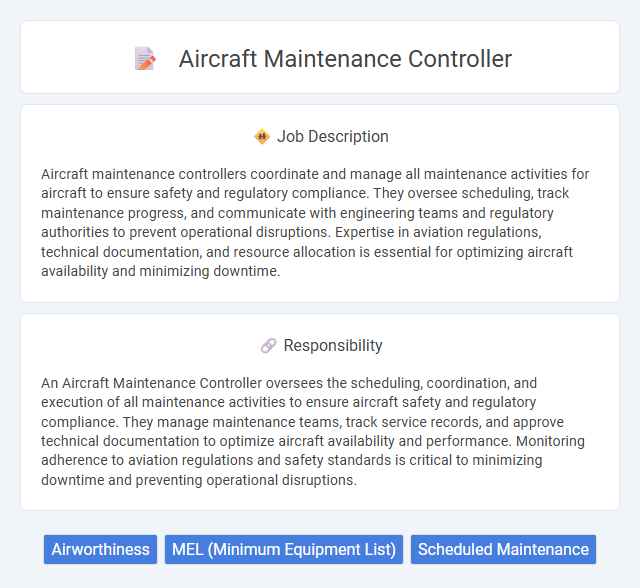
Aircraft maintenance controllers coordinate and manage all maintenance activities for aircraft to ensure safety and regulatory compliance. They oversee scheduling, track maintenance progress, and communicate with engineering teams and regulatory authorities to prevent operational disruptions. Expertise in aviation regulations, technical documentation, and resource allocation is essential for optimizing aircraft availability and minimizing downtime.
Individuals with a strong attention to detail and the ability to stay calm under pressure are likely suitable for an Aircraft Maintenance Controller role, as the job requires precise coordination and quick decision-making. Those who can effectively communicate with technical teams and manage multiple tasks simultaneously probably adapt well to this position. People prone to high stress or difficulty concentrating might face challenges in maintaining the safety and compliance standards essential for this job.
Qualification
Aircraft maintenance controllers require a strong foundation in aviation principles, typically demonstrated through a diploma or degree in aerospace engineering, aviation maintenance, or a related field. Certification such as an Aircraft Maintenance Engineer (AME) license or equivalent is often mandatory to ensure compliance with safety and regulatory standards. Proven experience in aircraft systems, maintenance schedules, and regulatory documentation further qualifies candidates to oversee maintenance operations effectively.
Responsibility
An Aircraft Maintenance Controller oversees the scheduling, coordination, and execution of all maintenance activities to ensure aircraft safety and regulatory compliance. They manage maintenance teams, track service records, and approve technical documentation to optimize aircraft availability and performance. Monitoring adherence to aviation regulations and safety standards is critical to minimizing downtime and preventing operational disruptions.
Benefit
An aircraft maintenance controller position likely offers significant benefits, including competitive salaries and comprehensive health insurance packages. Job stability and opportunities for career progression may also be prevalent due to the critical nature of aviation safety. Employees might enjoy access to advanced training programs, enhancing their skills and long-term employability.
Challenge
Aircraft maintenance controllers likely face significant challenges in ensuring the timely coordination of repairs and inspections under strict safety regulations. The role probably requires managing unexpected technical issues and resource constraints while maintaining aircraft readiness. High-pressure decision-making and adherence to rigorous maintenance schedules are expected to be key difficulties in this job.
Career Advancement
Aircraft maintenance controllers oversee and coordinate aircraft repair and inspection schedules to ensure safety and regulatory compliance. Career advancement opportunities include moving into senior management roles such as maintenance manager or operations director, often requiring certifications like the FAA Airframe and Powerplant license. Gaining expertise in emerging aviation technologies and strong leadership skills can accelerate promotion prospects within airlines, maintenance organizations, or aerospace companies.
Key Terms
Airworthiness
Aircraft maintenance controllers ensure the airworthiness of aircraft by supervising and coordinating maintenance activities to comply with safety regulations and manufacturer standards. They manage maintenance schedules, oversee inspections, and validate repair work to guarantee that aircraft remain fit for flight operations. Their role is critical in preventing mechanical failures and ensuring regulatory compliance for safe and reliable aviation performance.
MEL (Minimum Equipment List)
An Aircraft Maintenance Controller manages and oversees compliance with the Minimum Equipment List (MEL), ensuring aircraft operate safely despite inoperative equipment within prescribed limits. They coordinate maintenance activities to address MEL discrepancies swiftly, minimizing delays and maintaining regulatory adherence according to FAA or EASA standards. Proficiency in interpreting MEL protocols and updating defect logs is crucial for optimizing aircraft availability and operational reliability.
Scheduled Maintenance
Aircraft maintenance controllers ensure the execution and monitoring of scheduled maintenance tasks to maintain airworthiness and compliance with aviation regulations. They coordinate inspections, repairs, and servicing based on manufacturers' guidelines and regulatory requirements from authorities like the FAA or EASA. Effective scheduled maintenance management minimizes aircraft downtime and enhances operational safety and reliability.
 kuljobs.com
kuljobs.com